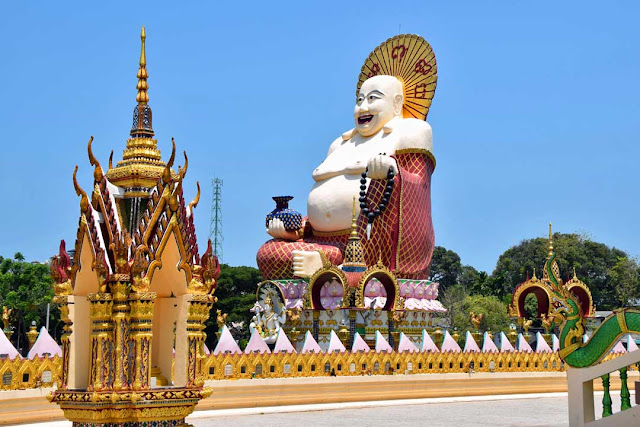March 17 Koh Samui
Samui Island is the east coast version of Phuket, on its way to becoming a major resort area. We opted for an air conditioned van ride through the heat and humidty to various sites on the island -- mostly Buddhist temples. The beaches that we saw, mostly from a distance, were empty. It was just too hot to enjoy any time on the beach. Independent snorkeling tours were popular, but for our first visit we wanted to stay with a ship's excursion.
On our sea day yesterday we had been shadowed by a column of war ships for most of the afternoon. Turns out they were going the same place we were. Our guide said that it was training for new cadets in the Thai Navy. The town of Na Thon where we went ashore was full of young guys in Navy workout clothing.
This is a spirit house. It's for the spirits of your departed elders.
First stop is the Wat Kunaram, famous for the mummified body of an 80-year old monk who died quietly while praying in the temple. The sunglasses are to hide the empty eye sockets, but it does make him look cool.
Samui used to be a major producer of coconuts. Men can harvest about 100 nuts/day. Samui farmers trained monkeys to harvest the coconuts, and they can do 1200/day. Coconuts are no longer big business, but they still demonstrate the technique to tourists.
The monkey demo is very near a Muslim fishing village, and they brought over the day's catch to sell to us.
A statue for Guan Yu, a second century Chinese warrior.
Wat Phrai Ya, or Big Buddha Temple
Peanut butter and banana pancakes!
Why did the chicken cross the puddle?
Wat Plai Laem, the most colorful temple on Koh Samui
Fat, laughing Buddha
Kwan Yin, the 18-armed Goddess of Mercy
Samui Island is the east coast version of Phuket, on its way to becoming a major resort area. We opted for an air conditioned van ride through the heat and humidty to various sites on the island -- mostly Buddhist temples. The beaches that we saw, mostly from a distance, were empty. It was just too hot to enjoy any time on the beach. Independent snorkeling tours were popular, but for our first visit we wanted to stay with a ship's excursion.
On our sea day yesterday we had been shadowed by a column of war ships for most of the afternoon. Turns out they were going the same place we were. Our guide said that it was training for new cadets in the Thai Navy. The town of Na Thon where we went ashore was full of young guys in Navy workout clothing.
This is a spirit house. It's for the spirits of your departed elders.
First stop is the Wat Kunaram, famous for the mummified body of an 80-year old monk who died quietly while praying in the temple. The sunglasses are to hide the empty eye sockets, but it does make him look cool.
Samui used to be a major producer of coconuts. Men can harvest about 100 nuts/day. Samui farmers trained monkeys to harvest the coconuts, and they can do 1200/day. Coconuts are no longer big business, but they still demonstrate the technique to tourists.
The monkey demo is very near a Muslim fishing village, and they brought over the day's catch to sell to us.
A statue for Guan Yu, a second century Chinese warrior.
Wat Phrai Ya, or Big Buddha Temple
Peanut butter and banana pancakes!
Why did the chicken cross the puddle?
Wat Plai Laem, the most colorful temple on Koh Samui
Fat, laughing Buddha
Kwan Yin, the 18-armed Goddess of Mercy


















2 comments:
what dave meant....they are still sending coconuts to mainland Thailand but evidently not so much with the help of the monkeys.
After seeing all these pictures, I think a temple tour may be our first choice for Ko Samui. We will be in this port on my birthday, so what I say we will do will rule ;-)
Post a Comment